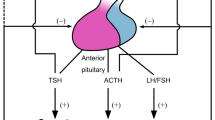Abstract
Psychoneuroendocrine research over the past two decades has provided clear evidence that clinical depression is frequently associated with hypersecretion of ACTH and cortisol. As a parent abnormality of this phenomenon, the resistance of ACTH and cortisol to the suppressive effect of dexamethasone was detected. This neuroendocrine probe (dexamethasone suppression test, DST) has received considerable interest as a validator of nosological concepts, a laboratory test to monitor clinical progress, and an ancillary aid for treatment selection. More recently, the availability of corticotropin-releasing hormone (CRH) has enabled researchers to study more closely the pathophysiology underlying altered regulation of the limbic-hypothalamic-pituitary-adrenocortical (LHPA) system. This overview highlights some of these new developments.
Access this chapter
Tax calculation will be finalised at checkout
Purchases are for personal use only
Preview
Unable to display preview. Download preview PDF.
Similar content being viewed by others
References
Halbreich U, Asnis GM, Shindldecker R, et al: Cortisol secretion in endogenous depression. II. Time related functions. Arch Gen Psychiatry 1985; 42: 904–914.
Amsterdam JD, Maislin G, Abelman E, et al: Adrenocortical responsiveness to the ACTH stimulation test in depressed patients and healthy volunteers. J Affective Disord 1986; 11: 265–274.
Carroll BJ, Feinberg M, Greden JF, et al: A specific laboratory test for the diagnosis of melancholia. Arch Gen Psychiatry 1981; 38: 15–22.
Berger M, Pirke KM, Doerr P, et al: The limited utility of the dexamethasone suppression test for the diagnostic process in psychiatry. Br J Psychiatry 1984; 145: 372–382.
Stokes PE, Stoll PM, Koslow SH, et al: Pretreatment DST and hypothalamic-pituitary-adrenocortical function in depressed patients and comparison groups. Arch Gen Psychiatry 1984; 41: 257–267.
Holsboer F, Philipp M, Steiger A, et al: Multisteroid analysis after DST in depressed patients—a controlled study. J Affective Disord 1986; 10: 241–249.
Holsboer F, Haack D, Gerken A, et al: Plasma dexamethasone concentrations and differential glucocorticoid suppression response in depressives and controls. Biol Psychiatry 1984; 19: 281–291.
Holsboer F, Wiedemann K, Gerken A, et al: The plasma dexamethasone variable in depression—test retest studies and early biophase kinetics. Psychiatry Res 1986; 17: 97–103.
Holsboer F, Wiedemann K, Boll E: Shortened dexamethasone half-live time in depressed dexamethasone nonsuppressors. Arch Gen Psychiatry 1986; 43: 813–815.
Wiedemann K, Holsboer F: Plasma dexamethasone kinetics during the DST after oral and intravenous administration of the test drug. Biol Psychiatry 1987; 22: 1340–1348.
Holsboer F, Liebl R, Hofschuster E: Repeated dexamethasone suppression test during depressive illness: normalization of test result compared with clinical improvement. J Affective Disord 1982; 4: 93–101.
Greden JA, Gardner R, King D, et al: Dexamethasone suppression tests in antidepressant treatment of melancholia—the process of normalization and test-retest reproducibility. Arch Gen Psychiatry 1983; 40: 493–500.
Holsboer F, Gerken A, von Bardeleben U, et al: Human corticotropin-releasing hormone in depression—correlation with thyrotropin secretion following thyrotropin releasing hormone. Biol Psychiatry 1986; 21: 601–611.
Gold PW, Loriaux DL, Roy A, et al: Responses to corticotropin-releasing hormone in the hypercortisolism of depression and Cushing’s disease: pathophysiologic and diagnostic implications. N Engl J Med 1986; 314: 1329–1335.
Holsboer F, von Bardeleben U, Buller R, et al: Stimulation response to corticotropin-releasing hormone (CRH) in patients with depression, alcoholism and panic disorder. Horm Metab Res 1987; 16 (Suppl.): 80–88.
Von Bardeleben U, Holsboer F, Stalla GK: Combined administration of human corticotropin-releasing factor and lysine vasopressin induces Cortisol escape from dexamethasone suppression in healthy subjects. Life Sci 1985; 37: 1613–1618.
Sapolsky RM, Krey LC, et al: Prolonged glucocorticoid exposure reduces hippocampal neuron number: implications for aging. J Neurosci 1985; 5: 1221.
Härfstrand A, Fuxe K, Cintra A, et al: Glucocorticoid receptor immunoreactivity in monoaminergic neurons of rat brain. Proc Nafl Acad Sci USA 1986; 83: 9779–9783.
Yamamoto KR: Steroid receptor regulated transcription of specific genes and gene networks. Annu Rev Genet 1985; 19: 209–252.
Editor information
Editors and Affiliations
Rights and permissions
Copyright information
© 1989 Springer-Verlag New York Inc.
About this chapter
Cite this chapter
Holsboer, F. (1989). Pathophysiology of the Limbic-Hypothalamic-Pituitary-Adrenocortex System: An Overview. In: Lerer, B., Gershon, S. (eds) New Directions in Affective Disorders. Springer, New York, NY. https://doi.org/10.1007/978-1-4612-3524-8_55
Download citation
DOI: https://doi.org/10.1007/978-1-4612-3524-8_55
Publisher Name: Springer, New York, NY
Print ISBN: 978-0-387-96769-1
Online ISBN: 978-1-4612-3524-8
eBook Packages: Springer Book Archive




